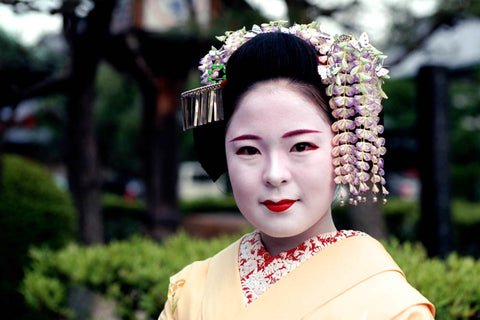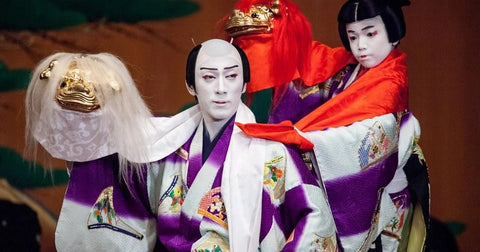Traditional Japanese Makeup: A Complete Guide to this Heritage

Traditional Japanese makeup styles have become the cultural symbols of the nation, going beyond the beauty standards in the past. This article walks you through every signature Japanese makeup look, traditional but still showing their effects on contemporary beauty and makeup styles.
1. Geisha
1.1. History
A geisha (芸者) usually wore this type of makeup, which made the Geisha makeup become the official name. Geishas are female Japanese highly skilled performing artists and entertainers trained in traditional Japanese performing arts styles. It was common when a Geisha dedicated years to mastering their craft, which made them beyond simply entertainers.
Geisha makeup is so signature that it has become one of the Japanese cultural symbols. The earliest version of Geisha was in the Heian Period (794 - 1185) then revolved throughout historical periods. It might become the distinctive geisha makeup we recognize today during the Edo period, between the 17th and 19th centuries.
1.2. Key features

Oshiroi (white foundation), Beni (red lips), and Hineri (eyebrows) are three key elements in Geisha makeup. Japanese women used rice powder to achieve a flawless, porcelain-like complexion after applying several layers.
The reason for such a thick layer of powder might be the lack of setting spays such as Kose setting spray like now to maintain their makeup. However, the thick application made it super difficult to remove makeup afterward due to the availability of makeup removal oil such as Shu Uemura cleansing oil.
Safflower or benibana were popular ingredients Geisha used to make the red color of lipsticks. Different shades and shapes of lip painting showcased the geisha's age and experience. Last but not least are meticulously sculpted eyebrows with a thin brush and black ink.
1.4. Cultural significance
Geisha makeup serves as a visual representation of sophistication, artistry, and cultural heritage. It depicts their dedication to their craft, their adherence to tradition, and their role as cultural ambassadors. There are many harmful stereotypes about Geisha culture; hence, it is crucial to recognize the complexities surrounding this Japanese cultural symbol for respect and appreciation.
2. Maiko
2.1. History
Maiko, or apprentice geisha, are captivating figures in Japanese culture, and their fame was mostly about their grace, artistry, and unique makeup style. The origin of Maiko makeup could have emerged around the 17th - 18th centuries alongside the geisha profession. Early maiko makeup likely borrowed elements from geisha makeup, yet their makeup style evolved and became distinct from geisha makeup to hold its own historical significance, symbolic meaning, and captivating beauty.
2.2. Key features

The white foundation of Maiko makeup was usually thicker than the Geisha style, in addition to an extended foundation down the neck and chest. The purpose of this look was to create a youthful and doll-like appearance.
The lipstick color that Maiko wore would be brighter red compared to geisha. Maiko usually painted their lips in a heart shape or round form back then.
Unlike the slender eyebrows of geisha, the style that Maiko used was in a softer and curved shape, conveying girls' innocence. Last but not least was Hanazome, a small red dot between the eyebrows, to symbolize good luck and the center of wisdom.
2.3. Cultural significance
The brighter colors and thicker foundation differentiate Maiko from Geisha as they are still in their training stage and are young ages. The Maiko makeup style has also become the Japanese symbol of culture.
3. Kabuki
3.1. History
Kabuki makeup is famous for its striking and dramatic makeup of performing artists. It has a rich history and plays a crucial role in conveying character, emotions, and symbolism within Kabuki plays. The origins of kabuki makeup can bring us back to the 17th century when the art form itself emerged. Early kabuki actors applied elements from Noh theater makeup with utilized simpler masks and symbolic markings.
3.2. Key features

Like the Geisha makeup style, Kabuki also used a white base (Oshiroi) from rice powder or zinc oxide. The white foundation supported highlighting dramatic elements of lines and patterns (Kumadori).
Kabuki-styled lines can be straight, curved, or broken to emphasize facial features such as eyes, eyebrows, and mouth. They can extend toward the temples or neck to create a mask-like effect. There were various patterns and symbols in Kabuki makeup with different meanings depicting the character's nature or social status. For example, checkered patterns might represent demons, while stylized cloud designs could indicate nobility.
3.3. Cultural significance
Kabuki is not just a makeup style but a visual language to convey the character's personality, social status, and emotional state in the play. In other words, it becomes a crucial tool for non-verbal communication, ensuring the audience grasps the intricacies of the characters and the narrative.
The elimination of extensive dialogue or exposition makes the play more interesting and worthwhile for deep observations. Kabuki embodies the rich traditions and artistic heritage of kabuki theater, which makes it a national treasure of Japan.
4. Cultural significance of Japanese traditional makeup
Beyond its aesthetic appeal, ancient traditional Japanese Makeup holds a deep significance within the cultural fabric of Japan. It transcends the definition of beauty itself but serves as a powerful visual language reflecting social status, artistic expression, and deeply rooted beliefs.
4.1. Social status
Makeup was historically the signal telling other people the social standing of a person, especially women. During the Edo period, elaborate makeup adorned the faces of aristocratic women and courtesans. Meanwhile, wearing minimal or no makeup indicated the individuals were commoners.
Besides, you could use a woman's makeup style as a hint for their marriage status. For example, if a woman had ohaguro (teeth blackening), round-topknot hairstyle, and unshaven eyebrows, she got married. Meanwhile, an unmarried girl would have a gorgeous hair ornament with a green-painted lower lip. The style was called the “sasa shirobeni” (bamboo grass-red rouge).
4.2. Art performing

You can easily find signature features of white foundation, red lips, and meticulously painted eyebrows in many old Japanese makeup styles, such as Geisha and kabuki makeup. These dramatic elements heightened the emotional impact of the performance, showing their role as cultural custodians or leaving a lasting impression on the audience.
4.3. Symbolism and meanings
More than for appearance, traditional Japanese makeup carries rich symbolism. For example, the white foundation represents purity and refinement, while red lips hint at sensuality and vitality. The dramatic lines in the kabuki style express the individual's personality and emotions.
The walkthrough of three traditional Japanese makeup styles, including Geisha, Maiko, and Kabuki, hopefully provides interesting insights into how Japanese women put their makeup in the past. You can see these styles transcend old beauty standards but carry rich cultural meanings and deep meanings.
Follow Japan With Love for more of such culture articles about Japanese beauty, makeup trends, and skincare products.

Dejar un comentario